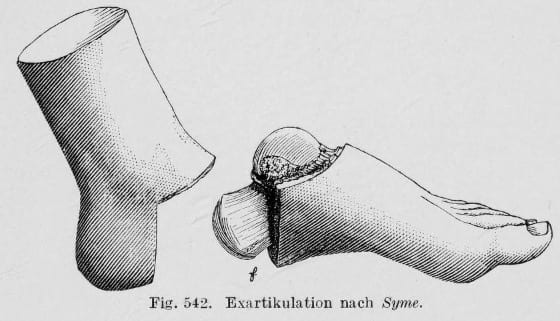James Syme

James Syme (1799–1870) was a Scottish General Surgeon
Referred to as the Napoleon of Surgery, James Syme was born to a family of renown in 1799 on Princes Street, Edinburgh. He attended the High School of Edinburgh before commencing his studies as a medical student at the University of Edinburgh. He never formally graduated, but did receive licence to practice from the Royal College of Surgeons.
In his early days, he trained at the Royal Infirmary, and at age 23 traveled to Paris where he attended Jacques Lisfranc’s course of operative surgery, and went on rounds with Guillaume Dupuytren. By age 24, he performed the first successful amputation of the hip ever done in Scotland.
A rivalry with fellow contemporary surgeon Robert Liston at the Royal Infirmary pushed him to open his own hospital at Minto House- equipped with 24 beds, and a suitable operating and lecture theatre.
The eponymous ankle amputation attributed to him was a triumph of conservative surgery in the days where more proximal amputations had much higher mortality rates.
Syme was one of the first advocates of the usage of antisepsis, and in his final clinical lecture delivered in 1868, he prophesised that this new principle was destined to revolutionise the practice of surgery.
Biography
- Born on November 7, 1799
- 1829 – Devised an operation for complete excision of the maxilla
- 1833 – Regius Professor of Clinical Surgery at Edinburgh
- 1847 – Departed Edinburgh for Chair of Surgery at University College. Returned 5 months later
- 1857 – Devised an operation for complete removal of the tongue
- 1858 – Advocated for the formation of the General Medical Council
- 1869 – Suffered a left-sided hemiplegia
- Died in 1870
His imperturbable coolness was contagious and he was generally well assisted. No one could be gentler, less exacting, or more easily satisfied ; and probably no surgeon was ever so simple in his tastes or requirements as to instruments.
Dr. Joseph Bell on James Syme
Medical Eponyms
Syme amputation (1831) (Extrartikulation nach Syme)
Syme’s amputation involves a disarticulation of the ankle at the tibiotalar joint. The heel pad is conserved and used to cover the distal end of the Tibia. The purported benefit is to allow weight bearing through the limb without the need for a prosthesis. In modern-day it is used chiefly in paediatric patients as the complication and re-amputation rates are lower than in adult populations.

Considering the great importance of preserving the heel, in respect both of utility and appearance, – to say nothing of the patient’s feelings, who would of course much rather part with the half of his foot than the half of his leg, it seems extraordinary that this operation should not hitherto have been introduced into the practice of British surgery.
James Syme, 1831
Major Publications
- Syme J. A probationary essay on necrosis. 1823
- Syme J. Case of osteo-sarcoma of the lower jaw. 1828
- Syme J. Treatise on the excision of diseased joints. 1831
- Syme J. The principles of surgery. 1832 (2e 1837)
- Syme J. On diseases of the rectum. 1838 (2e 1846; 3e 1954)
- Syme J. Contributions to the pathology and practice of surgery. 1848
- Syme J. On stricture of the urethra and fistula in perineo. 1849
- Syme J. Observations in clinical surgery. 1861
- Syme J. Clinical Observations. Oesophagotomy for the removal of a copper coin which had remained for three months in the gullet Br Med J. 1862 Mar 22; 1(64): 299.
- Syme J. Illustrations of the antiseptic principle of treatment in surgery. Br Med J. 1868 Jan 4; 1(366): 1–2.
References
Biography
- Obituary. James Syme. Br Med J. 1870; 2: 21
- Paterson R. Memorials of the life of James Syme; professor of clinical surgery in the University of Edinburgh. 1874
- Miles A. James Syme (1799-1870). In: The Edinburgh school of surgery before Lister. 1918: 174-212
- Nova and Vetera. The Napoleon of Surgery. Br Med J. 1954 Jan 16; 1(4854): 151
- Graham JM. James Syme (1799–1870). British Journal of Plastic Surgery. 1954; 7: 1-12
- Banov L, Banov J. James Syme (1799–1870), a great surgeon who promoted proctology. Diseases of the Colon & Rectum, 1970; 13(6): 475–479
- Dunea G. James Syme, the Napoleon of surgery (1799–1870). Hektopen International. 2019
- Bibliography. Syme, James 1799-1870. WorldCat Identities
Eponymous terms
- Garrè C, Borchard A. Amputation und Exartikulationen. Lehrbuch der Chirurgie, 1922: 693-695
- Braaksma R. et al. Syme amputation – a systematic review. Foot & Ankle International 2018, Vol. 39(3) 284–291
- Cadogan M. Eponymythology of foot injuries. LITFL
Eponym
the person behind the name
